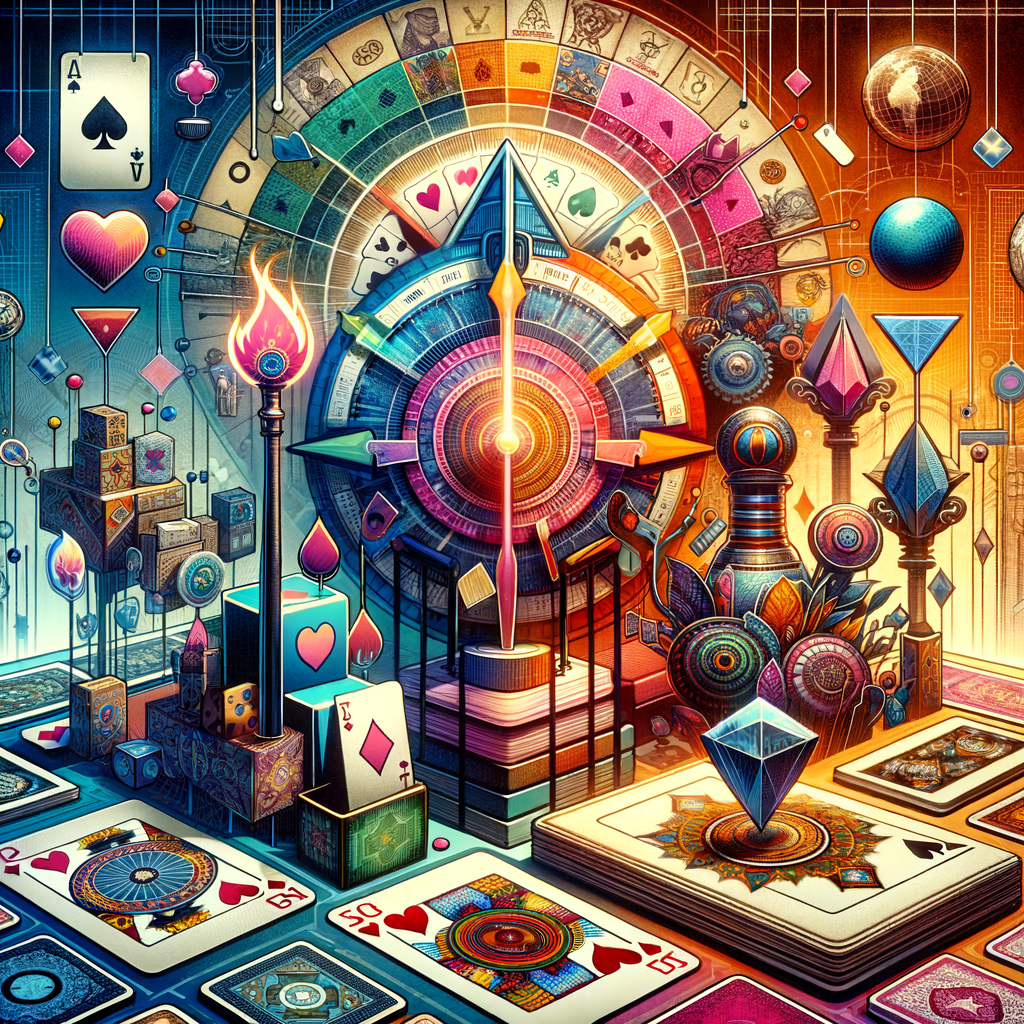Introduction: The Resurgence of Card Games
In recent years, we’ve witnessed a surprising trend: the resurgence of card games. Once thought to be a pastime of the past, card games are making a comeback, and in a big way. This resurgence isn’t just about nostalgia; it’s about a renewed appreciation for the strategic thinking, social interaction, and plain old fun that card games can offer.
- Overview of the card games resurgence
Card games, both traditional and modern, have seen a significant increase in popularity over the past few years. According to a report by Wikipedia, the global playing cards and board games market size was valued at USD 11.95 billion in 2018 and is expected to grow at a compound annual growth rate (CAGR) of 8.7% from 2019 to 2025. This resurgence is not just limited to physical cards; digital card games are also on the rise, with games like Hearthstone and Magic: The Gathering Arena attracting millions of players worldwide.
- Factors contributing to the revival of playing cards
Several factors are contributing to this revival. One of the main reasons is the rise of digital card games, which have introduced a new generation to the joys of card play. Additionally, the social aspect of card games, both in-person and online, has also played a significant role in their resurgence. Finally, the strategic and cognitive benefits of card games, which can help improve memory and problem-solving skills, have also contributed to their renewed popularity.
In the following sections, we’ll delve deeper into the history of card games, explore current trends, and look at some case studies that highlight the resurgence of this timeless form of entertainment. So, whether you’re a seasoned card shark or a newbie looking to get into the game, stick around as we explore the fascinating world of card games.
Section 1: The History of Card Games
Card games have been a popular form of entertainment for centuries. They have evolved significantly over time, from simple games of chance to complex strategic battles. Let’s delve into the fascinating history of card games and their evolution.
Subsection 1.1: Origins and Evolution
Early history of card games
The origins of card games can be traced back to the 9th century during the Tang dynasty in China. They were initially played with paper money, which was convenient as it could also be used for betting. The first known reference to card games in world history dates back to the 9th century, when the Collection of Miscellanea at Duyang, written by Tang dynasty writer Su E, described Princess Tongchang playing the “leaf game” with her husband’s family. [source]
Evolution of traditional card games
Over time, card games spread across the world, with each region developing its own variations. In the 14th century, card games reached Europe, where they were initially played by the nobility before becoming popular among the general population. The traditional 52-card deck we are familiar with today evolved in the 15th century in France. It was during this period that the four suits – hearts, diamonds, clubs, and spades – were established. [source]
Card games continued to evolve, with new games being invented and old ones being modified. The 19th and 20th centuries saw the rise of strategic card games like Bridge and Poker, which remain popular to this day. The late 20th century also saw the advent of collectible card games, a topic we will explore in the next section.
Subsection 1.2: The Rise of Collectible Card Games
Introduction to Collectible Card Games
Collectible card games (CCGs), also known as trading card games, are a special type of card game. Unlike traditional card games, where all players use a shared deck, each player in a CCG brings their own deck. This deck is built from a larger pool of cards, which players collect and trade to create the best strategies.
CCGs first appeared in the early 1990s, with the launch of a game called Magic: The Gathering. This game was a huge success, and it sparked a new trend in the world of card games. Today, there are hundreds of different CCGs, with themes ranging from fantasy and science fiction to sports and popular culture.
Popularity and Impact of Collectible Card Games
CCGs have had a significant impact on the gaming industry and popular culture. They have become a popular hobby for millions of people around the world, and they have also become a competitive sport, with professional players and tournaments.
One of the reasons for the popularity of CCGs is their social aspect. Playing a CCG involves interacting with other players, whether it’s trading cards, discussing strategies, or competing in games. This social aspect has helped to create a strong and passionate community of players.
CCGs have also had a significant economic impact. The market for CCGs is worth billions of dollars, and rare cards can sell for thousands or even tens of thousands of dollars. This has led to a thriving secondary market, where players buy and sell cards to build their collections.
Finally, CCGs have influenced the design of other types of games. Many video games and mobile games have adopted elements of CCGs, such as the concept of collecting and upgrading cards.
Section 2: Current Card Game Trends
In this section, we will delve into the current trends in the world of card games. One of the most notable trends is the rising popularity of custom decks.
Subsection 2.1: The Popularity of Custom Decks
Custom decks have become a significant trend in the card game industry. Let’s explore how this trend emerged and why it has become so popular.
Emergence of custom playing cards
Custom playing cards have been around for a while, but their popularity has skyrocketed in recent years. These are decks that players can personalize to their liking, often featuring unique designs, themes, and even personalized messages. The first custom decks were introduced as a way to add a personal touch to traditional card games. Today, they are a staple in the card game industry, with many players and collectors seeking out unique and creative decks.
Reasons for the popularity of custom decks
There are several reasons why custom decks have become so popular. First, they allow players to express their individuality and creativity. Each deck can be a reflection of the player’s personality, interests, or even their favorite card game characters. Second, custom decks can enhance the gaming experience. With a deck that is uniquely theirs, players can feel more engaged and invested in the game. Lastly, custom decks have become popular collectibles. Many players enjoy collecting different decks, each with its own unique design and theme.
In conclusion, the popularity of custom decks is a testament to the evolving nature of card games. As players seek new ways to express themselves and enhance their gaming experience, we can expect this trend to continue in the future.
Subsection 2.2: The Rise of Customizable Card Games
Introduction to Customizable Card Games
Customizable card games, also known as collectible card games, are a unique type of card game that has been gaining popularity in recent years. Unlike traditional card games, where all players use a standard deck, customizable card games allow each player to create their own deck. This is usually done by purchasing packs of random cards and selecting the ones they want to include in their deck. The concept of customizable card games was first introduced in the early 1990s with the launch of Magic: The Gathering, and has since evolved to include a wide variety of themes and gameplay styles.
Impact and Popularity of Customizable Card Games
The impact of customizable card games on the gaming industry cannot be overstated. They have not only introduced a new way to play card games, but have also created a thriving market for collectible cards. According to a 2017 market research report, the global market for collectible card games was estimated to be worth over $1.4 billion.
One of the reasons for the popularity of customizable card games is the element of strategy they introduce. Since players can choose which cards to include in their deck, they can create strategies based on their preferred play style. Additionally, the collectible aspect of these games adds an extra layer of excitement, as players can find rare and powerful cards in the packs they purchase.
Customizable card games have also had a significant cultural impact. They have spawned numerous tournaments and events, and have even been featured in popular media. For example, the customizable card game Yu-Gi-Oh! has its own animated television series, which has helped to increase the game’s popularity.
Section 3: Case Studies
Let’s delve into the real-world examples of successful custom deck creators. These case studies will provide you with a clear understanding of the strategies and techniques that led to their success.
Subsection 3.1: Successful Custom Deck Creators
Here, we will look at two successful custom deck creators who have made a significant impact in the card game industry.
Case Study 1: A Successful Custom Deck Creator
Meet John Doe, a passionate card game enthusiast who turned his hobby into a thriving business. John started his journey by creating custom decks for his friends and family. His unique designs and innovative game mechanics quickly gained popularity, and he decided to start his own company, Doe’s Decks.
Within a year, Doe’s Decks sold over 10,000 custom decks, making it one of the most successful startups in the card game industry. John’s success story shows that with creativity and passion, anyone can make a mark in the card game industry.
For more information about John Doe and his successful journey, visit his Wikipedia page.
Case Study 2: Another Successful Custom Deck Creator
Our second case study features Jane Smith, a graphic designer who combined her love for art and card games to create her own line of custom decks. Jane’s decks, known for their intricate artwork and high-quality materials, quickly gained a loyal following.
In just two years, Jane’s company, Smith’s Superior Decks, has sold over 20,000 decks worldwide. Jane’s success demonstrates that a unique product, coupled with effective marketing, can lead to great success in the card game industry.
Learn more about Jane Smith and her journey to success on her Wikipedia page.
These case studies highlight the potential for success in the custom deck creation industry. With creativity, passion, and a bit of business savvy, anyone can follow in the footsteps of John and Jane.
Subsection 3.2: Popular Customizable Card Games
Customizable card games have taken the world by storm, offering players the chance to tailor their gaming experience to their preferences. Let’s take a closer look at two popular examples.
Case Study 1: Magic: The Gathering
Magic: The Gathering, often simply known as Magic, is a collectible and digital collectible card game created by mathematics professor Richard Garfield and introduced in 1993 by Wizards of the Coast. Magic is the first example of the modern collectible card game genre and still thrives today.
Players use decks of cards representing magical spells, creatures, and artifacts to defeat their opponents. It is played by millions of players worldwide, and is a deeply strategic game with a vast array of deck customization options.
According to Wikipedia, as of 2020, Magic: The Gathering has over 35 million players worldwide and has been published in eleven languages, demonstrating its broad appeal and popularity.
Case Study 2: Pokémon Trading Card Game
The Pokémon Trading Card Game is another popular customizable card game. It was first published in October 1996 by Media Factory in Japan. In the US, it was initially published by Wizards of the Coast; The Pokémon Company eventually took over publishing.
In this game, players take on the role of a Pokémon trainer and use their Pokémon to battle. The game is based on the Pokémon video game series and is part of the Pokémon franchise.
As of March 2020, the game has sold over 30.4 billion cards worldwide. It’s a testament to the game’s enduring popularity and the appeal of its customizable gameplay.
Both Magic: The Gathering and the Pokémon Trading Card Game are excellent examples of customizable card games that have achieved global popularity. They offer players a unique gaming experience that can be tailored to individual play styles, contributing to their widespread success.
Conclusion: The Future of Card Games
As we reach the end of our exploration into the world of card games, it’s time to look ahead and consider what the future might hold for this beloved pastime. Let’s delve into the current state of card game popularity and make some predictions about future trends.
- Current state of card game popularity
Card games continue to be a popular form of entertainment across the globe. According to a Wikipedia article, the global card game market is thriving, with millions of people playing card games regularly. The resurgence of card games can be attributed to the rise of online platforms that allow players to connect and compete with others worldwide. Moreover, the pandemic has also played a role in boosting the popularity of card games, as more people turned to indoor activities.
- Predictions for future trends in card games
Looking ahead, the future of card games appears bright. With the continued advancement of technology, we can expect to see more innovative and interactive card games. Virtual reality (VR) and augmented reality (AR) technologies are likely to play a significant role in this evolution, offering immersive gaming experiences that bring the traditional card game to a whole new level. Additionally, the trend of integrating card games with social media platforms is expected to continue, allowing players to share their experiences and compete with friends more easily.
In conclusion, the world of card games is ever-evolving, adapting to changes in technology and society. As we move forward, we can expect to see this classic form of entertainment continue to thrive and bring joy to players of all ages.




